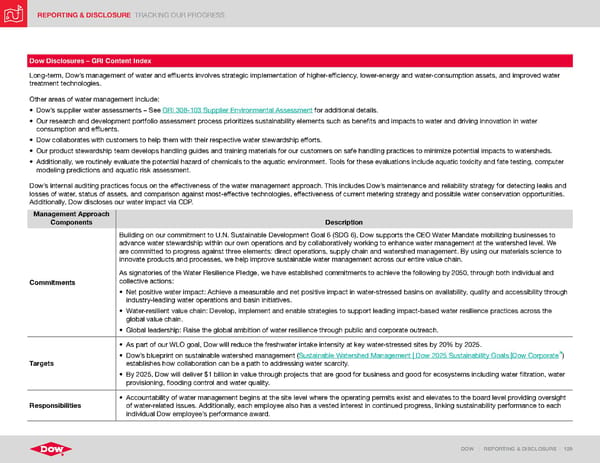REPORTING & DISCLOSURE TRACKING OUR PROGRESS DOW | REPORTING & DISCLOSURE | 129 Dow Disclosures – GRI Content Index Long-term, Dow’s management of water and effluents involves strategic implementation of higher-efficiency, lower-energy and water-consumption assets, and improved water treatment technologies. Other areas of water management include: • Dow’s supplier water assessments – See GRI 308-103 Supplier Environmental Assessment for additional details. • Our research and development portfolio assessment process prioritizes sustainability elements such as benefits and impacts to water and driving innovation in water consumption and effluents. • Dow collaborates with customers to help them with their respective water stewardship efforts. • Our product stewardship team develops handling guides and training materials for our customers on safe handling practices to minimize potential impacts to watersheds. • Additionally, we routinely evaluate the potential hazard of chemicals to the aquatic environment. Tools for these evaluations include aquatic toxicity and fate testing, computer modeling predictions and aquatic risk assessment. Dow’s internal auditing practices focus on the effectiveness of the water management approach. This includes Dow’s maintenance and reliability strategy for detecting leaks and losses of water, status of assets, and comparison against most-effective technologies, effectiveness of current metering strategy and possible water conservation opportunities. Additionally, Dow discloses our water impact via CDP. Management Approach Components Description Commitments Building on our commitment to U.N. Sustainable Development Goal 6 (SDG 6), Dow supports the CEO Water Mandate mobilizing businesses to advance water stewardship within our own operations and by collaboratively working to enhance water management at the watershed level. We are committed to progress against three elements: direct operations, supply chain and watershed management. By using our materials science to innovate products and processes, we help improve sustainable water management across our entire value chain. As signatories of the Water Resilience Pledge, we have established commitments to achieve the following by 2050, through both individual and collective actions: • Net positive water impact: Achieve a measurable and net positive impact in water-stressed basins on availability, quality and accessibility through industry-leading water operations and basin initiatives. • Water-resilient value chain: Develop, implement and enable strategies to support leading impact-based water resilience practices across the global value chain. • Global leadership: Raise the global ambition of water resilience through public and corporate outreach. Targets • As part of our WLO goal, Dow will reduce the freshwater intake intensity at key water-stressed sites by 20% by 2025. • Dow’s blueprint on sustainable watershed management ( Sustainable Watershed Management | Dow 2025 Sustainability Goals |Dow Corporate ) establishes how collaboration can be a path to addressing water scarcity. • By 2025, Dow will deliver $1 billion in value through projects that are good for business and good for ecosystems including water filtration, water provisioning, flooding control and water quality. Responsibilities • Accountability of water management begins at the site level where the operating permits exist and elevates to the board level providing oversight of water-related issues. Additionally, each employee also has a vested interest in continued progress, linking sustainability performance to each individual Dow employee’s performance award.
 ESG Report | Dow Page 128 Page 130
ESG Report | Dow Page 128 Page 130